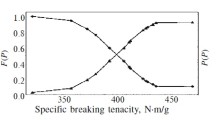We have studied the characteristic features of deformation in aramid fabrics with different weaves during penetration by an indenter (in the form of a double-edged knife) at slow speed. We have established a relationship between the degree of binding of warp and weft yarns in the fabric and its resistance to stabbing with a knife. In order to achieve significant frictional interaction between yarns during penetration of the knife, yarns in one of the sets of yarns should be crimped as much as possible. The results obtained can be used in developing effective protection from a cold steel weapon.







Similar content being viewed by others
References
P. E. Safonov, N. M. Levakova et al., Topics in Defense Technology. Series 15. Composite Nonmetallic Materials in Engineering Nos. 3(170)-4(171) [in Russian], NTTs Informtekhnika, Moscow (2013); pp. 27-33.
O. E. Chernyaeva, “Advances in the technology for manufacture of specialty technical fabrics from aramid yarns on Dornier looms,” Dissertation in competition for the academic degree of Candidate of Technical Sciences, IGTA, Ivanovo (2010). 185 pp.
E. F. Kharchenko and A. F. Ermolenko, Composite, Textile, and Combination Body Armor Materials. Vol. 1. Mechanisms for Interaction with Ballistic Threats [in Russian], TsNIISM, Moscow (2013), p. 294.
P. E. Safonov, S. S. Yukhin et al., Izv. Vuzov. Tekhnol. Tekst. Prom-sti, No. 5 (347), 44-48 (2013).
V. A. Grigoryan, I. F. Kobylkin et al., in: V. A. Grigoryan, ed., Materials and Protective Structures for Localized and Personal Body Armor [in Russian], RadioSoft, Moscow (2008). 406 pp.
S. Zbigniew, Fibers and Textiles in Eastern Europe, 19, No. 4(87), 74-80 (2011).
P. M. Cunniff, “Dimensionless parameters for optimization of textile-based body armor systems,” in: Proceedings of the Eighteenth International Symposium on Ballistics, San Antonio, Texas USA, 1999.
Cheng-Kun Chu and Yu-Liang Chen, Fibers and Textiles in Eastern Europe, 18, No. 6(83), 63-67 (2010).
E. F. Kharchenko, “Major stages in the process of interaction of bullets and fragments with textile body armor materials,” in: Abstracts, Eighth International Conference on the Latest Trends in Design and Application of Ballistic Materials and Protective Equipment [in Russian], Khot’kovo (2005), pp. 5-9.
E. F. Kharchenko, N. A. Zelenov, and V. A. Aniskovich, “Decomposition of the energy of a bullet into components during interaction with a textile body armor panel,” in: Abstracts, Eighth International Conference on the Latest Trends in Design and Application of Ballistic Materials and Protective Equipment [in Russian], Khot’kovo (2005), pp. 9-11.
V. G. Bova, A. I. Slugin et al., “Ballistic fabrics based on aramid staple fiber,” in: Abstracts, Eleventh International Conference on the Latest Trends in Design and Application of Ballistic Materials and Protective Equipment [in Russian], Khot’kovo (2010), pp. 22-23.
S. L. Bazhenov and G. P. Goncharuk, Polymer Sci., Ser. A, 56, No. 2, 184-195 (2014).
M. Karahan and N. Karahan, Fibers and Textiles in Eastern Europe, 22, No. 3(105), 109-115 (2014).
M. Karahan and K. Yildirim, Fibers and Textiles in Eastern Europe, 23, No. 3(111), 97-105 (2015).
Magdi El Messiry and Eman Eltahan, J. Ind. Text. (published online before print, September 16, 2014). doi:10.1177/1528083714551441.
Ya. I. Bulanov, A. V. Kurdenkova, and Yu. S. Shustov, Dizain i Tekhnologii, No. 45(87), 62-67 (2015).
S. D. Nikolaev, A. A. Martynova et al., Methods and Tools for Studying Technological Processes in Weaving [in Russian], MGTU im. A. N. Kosygina, Moscw (2003). 336 pp.
Author information
Authors and Affiliations
Corresponding author
Additional information
Translated from Khimicheskie Volokna, Vol. 48, No. 6, pp. 34-41, November-December, 2016.
Rights and permissions
About this article
Cite this article
Safonov, P.E., Yukhin, S.S. Deformation of Aramid Fabrics with Different Structures During Low-Speed Penetration by an Indenter. Review. Fibre Chem 48, 478–486 (2017). https://doi.org/10.1007/s10692-017-9821-y
Published:
Issue Date:
DOI: https://doi.org/10.1007/s10692-017-9821-y




